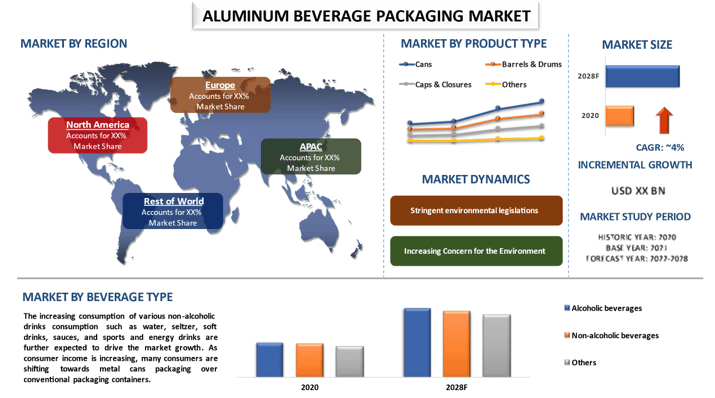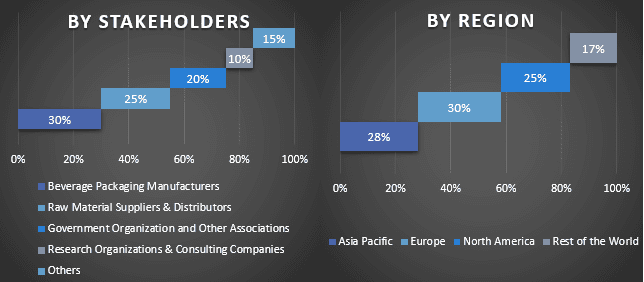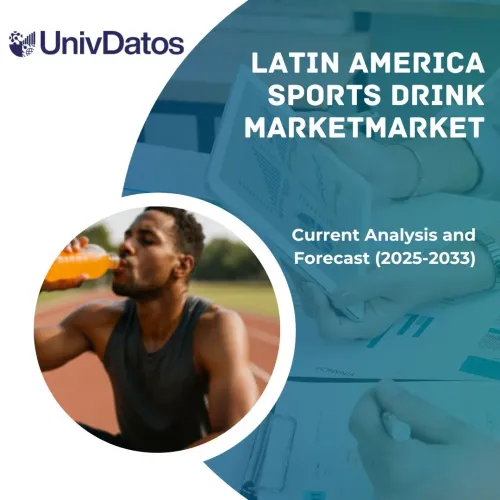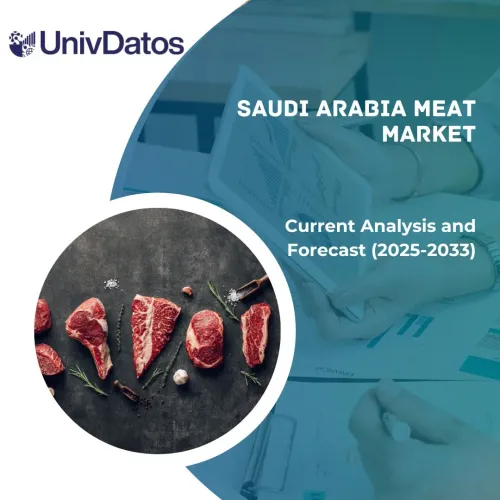- Startseite
- Über uns
- Industrie
- Dienstleistungen
- Lesen
- Kontaktieren Sie uns
Aluminiumverpackungsmarkt für Getränke: Aktuelle Analyse und Prognose (2022-2028)
Schwerpunkt auf Produkttyp (Dosen, Fässer & Trommeln, Kappen & Verschlüsse und Sonstige); Getränkeart (Alkoholische Getränke, Nichtalkoholische Getränke und Sonstige); und Region/Land

Es wird erwartet, dass der globale Markt für Aluminiumgetränkeverpackungen im Prognosezeitraum mit einer beträchtlichen Rate von rund 4 % wachsen wird. Aluminiumgetränkeverpackungen sind ein wichtiges Material für Laminate, das auch in der Lebensmittelverpackungsindustrie in großem Umfang verwendet wird. Es ist besser als jedes andere kunststofflaminierte Material gegen Feuchtigkeit, Sauerstoff und andere Gassatzungen sowie Lichteinwirkung. Der Markt für Aluminiumgetränkeverpackungen wird durch die steigende Nachfrage nach Lebensmitteln und Getränken über Online-Lebensmittelkanäle angetrieben. Darüber hinaus ist der Anstieg des Einsatzes von Getränkeverpackungsmaterialien größtenteils auf die steigende Nachfrage nach kohlensäurehaltigen Getränken, Sportgetränken, Fruchtsäften und anderen Getränken zurückzuführen. Darüber hinaus hat sich die Verpackung zu einem Marketinginstrument entwickelt.
Darüber hinaus wird erwartet, dass zunehmende Regierungsinitiativen zur Reduzierung des Kunststoffeinsatzes die Akzeptanzrate von biologisch abbaubaren und recycelbaren Kunststoffen weltweit senken werden. Darüber hinaus haben mehrere Nationen die Verwendung von aus Erdöl gewonnenem Kunststoff verboten, um ihre Kohlenstoffemissionen zu reduzieren. Infolgedessen wird die Expansion nachhaltiger Verpackungslösungen der globalen Getränkeindustrie durch die zunehmende staatliche Unterstützung beflügelt.
Ardagh Group S.A., Ball Corporation, Crown Holdings Inc., Amcor plc, COFCO Packaging Holdings Co. Ltd., Sonoco Products Company, Kian Joo Factory Berhad, Anheuser-Busch Companies LLC, CANPACK Group und Silgan Containers LLC. sind einige der wichtigsten Akteure auf dem Markt. Mehrere M&As sowie Partnerschaften wurden von diesen Akteuren eingegangen, um Kunden mit Hightech- und innovativen Produkten/Technologien zu unterstützen.
Im Bericht vorgestellte Erkenntnisse
„Unter den Produkttypen wird die Kategorie Dosen im Prognosezeitraum einen robusten CAGR erleben“
Basierend auf der Art ist der Markt in Dosen, Fässer und Trommeln, Verschlüsse und andere unterteilt. Unter ihnen wird die Kategorie der Dosen im Prognosezeitraum einen höheren CAGR erleben, was auf die steigende Nachfrage aufgrund der verschiedenen Vorteile zurückzuführen ist, die sie bietet, wie z. B. billiger Preis, sichere Verpackungslösung, geringes Gewicht, Haltbarkeit und einfache Transport. Darüber hinaus fördert die wachsende Durchdringung von Fast-Food-Ketten, die verschiedene Getränke in ihren erschwinglichen Mahlzeiten anbieten, den Konsum von Säften und Erfrischungsgetränken und treibt so den Konsum von Aluminiumgetränkeverpackungen in der Region voran.
„Unter den Getränketypen werden die alkoholfreien Getränke im Jahr 2020 einen bedeutenden Anteil am Markt halten“
Auf der Grundlage des Antriebstyps ist der Markt in alkoholische Getränke, alkoholfreie Getränke und andere unterteilt. Unter diesen werden alkoholfreie Getränke im Jahr 2020 einen bedeutenden Anteil am Markt halten. Dies ist hauptsächlich auf den steigenden Konsum verschiedener alkoholfreier Getränke wie Wasser, Selters, Erfrischungsgetränke, Soßen sowie Sport- und Energy-Drinks zurückzuführen, der das Marktwachstum voraussichtlich weiter ankurbeln wird. Da das Verbrauchereinkommen steigt, verlagern sich viele Verbraucher von herkömmlichen Verpackungsbehältern zu Metallverpackungen.
„APAC wird einen bedeutenden Anteil am Markt halten“
Für ein besseres Verständnis der Marktakzeptanz von Aluminiumgetränkeverpackungen wird der Markt basierend auf seiner weltweiten Präsenz in den Ländern Nordamerika (USA, Kanada, Restliches Nordamerika), Europa (Deutschland, Großbritannien, Frankreich, Spanien, Italien, Restliches Europa), Asien-Pazifik (China, Japan, Indien, Restliches Asien-Pazifik), Rest der Welt analysiert. Es wird erwartet, dass APAC im Prognosezeitraum mit einem beträchtlichen CAGR wachsen wird. Dies ist hauptsächlich auf die schnell wachsende Bevölkerung in Verbindung mit dem steigenden Konsum von funktionellen Getränken zurückzuführen. Darüber hinaus der Anstieg der Cafés, Hotels und Restaurants in der gesamten Region in Verbindung mit dem Wachstum der Reise- und Tourismusbranche und der steigenden Attraktivität von Quick Service Restaurants (QSRs) bei den Millennials. Laut Statista variierte die Anzahl der Gastronomiebetriebe weltweit im Jahr 2020 stark nach Region. Asien-Pazifik hatte mit über 17 Millionen die meisten Betriebe. Im Vergleich dazu war die Region mit der zweithöchsten Anzahl von Gastronomiebetrieben Lateinamerika mit über 2,3 Millionen.
Gründe für den Kauf dieses Berichts:
- Die Studie umfasst eine Marktdimensionierungs- und Prognoseanalyse, die von authentifizierten wichtigen Branchenexperten validiert wurde.
- Der Bericht bietet einen schnellen Überblick über die Gesamtleistung der Branche auf einen Blick.
- Der Bericht behandelt eine eingehende Analyse prominenter Branchenkollegen mit einem primären Fokus auf wichtige Unternehmenskennzahlen, Produktportfolio, Expansionsstrategien und aktuelle Entwicklungen.
- Detaillierte Untersuchung von Treibern, Beschränkungen, wichtigen Trends und Chancen in der Branche.
- Die Studie deckt den Markt umfassend über verschiedene Segmente hinweg ab.
- Tiefgreifende regionale Analyse der Branche.
Anpassungsoptionen:
Der globale Markt für Aluminiumgetränkeverpackungen kann je nach Anforderung oder einem anderen Marktsegment weiter angepasst werden. Darüber hinaus versteht UMI, dass Sie möglicherweise Ihre eigenen geschäftlichen Anforderungen haben. Zögern Sie daher nicht, uns zu kontaktieren, um einen Bericht zu erhalten, der Ihren Anforderungen vollständig entspricht.
Inhaltsverzeichnis
Forschungsansatz für die Analyse des Marktes für Getränkeverpackungen aus Aluminium (2022-2028)
Die Analyse des historischen Marktes, die Schätzung des aktuellen Marktes und die Prognose des zukünftigen Marktes für den globalen Markt für Getränkeverpackungen aus Aluminium waren die drei Hauptschritte, die unternommen wurden, um die Einführung von Getränkeverpackungen aus Aluminium in wichtigen Regionen weltweit zu erstellen und zu analysieren. Es wurden umfassende Sekundärrecherchen durchgeführt, um die historischen Marktzahlen zu erfassen und die aktuelle Marktgröße zu schätzen. Zweitens wurden zahlreiche Erkenntnisse und Annahmen berücksichtigt, um diese Erkenntnisse zu validieren. Darüber hinaus wurden umfassende Primärinterviews mit Branchenexperten entlang der Wertschöpfungskette des globalen Marktes für Getränkeverpackungen aus Aluminium geführt. Nach der Annahme und Validierung der Marktzahlen durch Primärinterviews haben wir einen Top-Down/Bottom-Up-Ansatz verwendet, um die vollständige Marktgröße zu prognostizieren. Danach wurden Methoden zur Aufschlüsselung des Marktes und zur Datentriangulation angewendet, um die Marktgröße von Segmenten und Untersegmenten der betreffenden Branche zu schätzen und zu analysieren. Die detaillierte Methodik wird im Folgenden erläutert:
Analyse der historischen Marktgröße
Schritt 1: Eingehende Studie von Sekundärquellen:
Es wurde eine detaillierte Sekundärstudie durchgeführt, um die historische Marktgröße des Marktes für Getränkeverpackungen aus Aluminium aus unternehmensinternen Quellen wie Jahresberichten und Finanzberichten, Leistungsvorträgen, Pressemitteilungen usw. und externen Quellen wie Fachzeitschriften, Nachrichten und Artikeln, Regierungsveröffentlichungen, Wettbewerbsveröffentlichungen, Branchenberichten, Drittanbieterdatenbanken und anderen glaubwürdigen Veröffentlichungen zu erhalten.
Schritt 2: Marktsegmentierung:
Nachdem wir die historische Marktgröße des Marktes für Getränkeverpackungen aus Aluminium erhalten hatten, führten wir eine detaillierte Sekundäranalyse durch, um historische Markteinblicke und Anteile für verschiedene Segmente und Untersegmente in wichtigen Regionen zu sammeln. Die wichtigsten im Bericht enthaltenen Segmente sind Produkttyp und Getränketyp. Darüber hinaus wurden Analysen auf Länderebene durchgeführt, um die allgemeine Akzeptanz von Testmodellen in dieser Region zu bewerten.
Schritt 3: Faktorenanalyse:
Nachdem wir die historische Marktgröße verschiedener Segmente und Untersegmente ermittelt hatten, führten wir eine detaillierte Faktorenanalyse durch, um die aktuelle Marktgröße des Marktes für Getränkeverpackungen aus Aluminium zu schätzen. Darüber hinaus führten wir eine Faktorenanalyse anhand von abhängigen und unabhängigen Variablen wie verschiedenen Produkttypen und Getränketypen von Geländefahrzeugen durch. Es wurde eine gründliche Analyse der Angebots- und Nachfrageszenarien unter Berücksichtigung der wichtigsten Partnerschaften, Fusionen und Übernahmen, Geschäftsausweitungen und Produkteinführungen im Bereich der Aluminium-Getränkeverpackungen weltweit durchgeführt.
Schätzung & Prognose der aktuellen Marktgröße
Aktuelle Marktgrößenbestimmung: Basierend auf den verwertbaren Erkenntnissen aus den obigen 3 Schritten haben wir die aktuelle Marktgröße, die wichtigsten Akteure auf dem globalen Markt für Getränkeverpackungen aus Aluminium und die Marktanteile der Segmente ermittelt. Alle erforderlichen prozentualen Anteile und Marktaufschlüsselungen wurden mithilfe des oben genannten sekundären Ansatzes ermittelt und durch Primärinterviews verifiziert.
Schätzung & Prognose: Für die Marktschätzung und -prognose wurden verschiedenen Faktoren Gewichte zugewiesen, darunter Treiber & Trends, Beschränkungen und Chancen, die den Stakeholdern zur Verfügung stehen. Nach der Analyse dieser Faktoren wurden relevante Prognosetechniken, d. h. der Top-Down/Bottom-Up-Ansatz, angewendet, um die Marktprognose für 2028 für verschiedene Segmente und Untersegmente in den wichtigsten Märkten weltweit zu erstellen. Die Forschungsmethodik zur Schätzung der Marktgröße umfasst:
- Die Marktgröße der Branche in Bezug auf den Umsatz (USD) und die Akzeptanzrate des Marktes für Getränkeverpackungen aus Aluminium in den wichtigsten Märkten im Inland
- Alle prozentualen Anteile, Aufteilungen und Aufschlüsselungen der Marktsegmente und -untersegmente
- Die wichtigsten Akteure auf dem globalen Markt für Getränkeverpackungen aus Aluminium in Bezug auf die angebotenen Produkte. Außerdem die von diesen Akteuren angewandten Wachstumsstrategien, um im schnell wachsenden Markt zu konkurrieren
Validierung von Marktgröße und -anteil
Primärforschung: Es wurden ausführliche Interviews mit den wichtigsten Meinungsbildnern (Key Opinion Leaders, KOLs) geführt, darunter Führungskräfte der obersten Ebene (CXO/VPs, Vertriebsleiter, Marketingleiter, Betriebsleiter, Regionalleiter, Landesleiter usw.) in den wichtigsten Regionen. Die Ergebnisse der Primärforschung wurden dann zusammengefasst, und es wurde eine statistische Analyse durchgeführt, um die aufgestellte Hypothese zu beweisen. Die Erkenntnisse aus der Primärforschung wurden mit den Ergebnissen der Sekundärforschung zusammengeführt, wodurch Informationen in verwertbare Erkenntnisse umgewandelt wurden.
Aufteilung der Primärteilnehmer in verschiedenen Regionen

Markt Engineering
Die Datentriangulationstechnik wurde angewendet, um die gesamte Marktschätzung abzuschließen und präzise statistische Zahlen für jedes Segment und Untersegment des globalen Marktes für Getränkeverpackungen aus Aluminium zu erhalten. Die Daten wurden in mehrere Segmente und Untersegmente aufgeteilt, nachdem verschiedene Parameter und Trends in den Bereichen Produkttyp und Getränketyp auf dem globalen Markt für Getränkeverpackungen aus Aluminium untersucht worden waren.
Das Hauptziel der Global Aluminum Beverage Packaging Market Study
Die aktuellen und zukünftigen Markttrends des globalen Marktes für Getränkeverpackungen aus Aluminium wurden in der Studie genau bestimmt. Investoren können strategische Einblicke gewinnen, um ihre Entscheidungen für Investitionen auf der Grundlage der in der Studie durchgeführten qualitativen und quantitativen Analyse zu treffen. Aktuelle und zukünftige Markttrends bestimmten die Gesamtattraktivität des Marktes auf regionaler Ebene und boten den Industrieteilnehmern eine Plattform, um den unerschlossenen Markt zu nutzen und von einem First-Mover-Vorteil zu profitieren. Weitere quantitative Ziele der Studien sind:
- Analyse der aktuellen und prognostizierten Marktgröße des Marktes für Getränkeverpackungen aus Aluminium in Bezug auf den Wert (USD). Analysieren Sie auch die aktuelle und prognostizierte Marktgröße verschiedener Segmente und Untersegmente
- Die Segmente in der Studie umfassen die Bereiche Produkttyp und Getränketyp.
- Definition und Analyse des regulatorischen Rahmens für Aluminium-Getränkeverpackungen.
- Analyse der Wertschöpfungskette unter Beteiligung verschiedener Intermediäre sowie Analyse des Kunden- und Wettbewerbsverhaltens der Branche.
- Analyse der aktuellen und prognostizierten Marktgröße des Marktes für Getränkeverpackungen aus Aluminium für die wichtigsten Regionen.
- Zu den wichtigsten Ländern der im Bericht untersuchten Regionen gehören der asiatisch-pazifische Raum, Europa, Nordamerika und der Rest der Welt.
- Unternehmensprofile des Marktes für Getränkeverpackungen aus Aluminium und die von den Marktakteuren angewandten Wachstumsstrategien, um sich in dem schnell wachsenden Markt zu behaupten
- Tiefgehende Analyse der Branche auf regionaler Ebene
Verwandt Berichte
Kunden, die diesen Artikel gekauft haben, kauften auch










